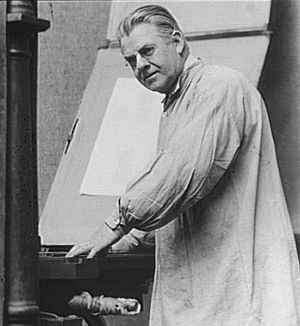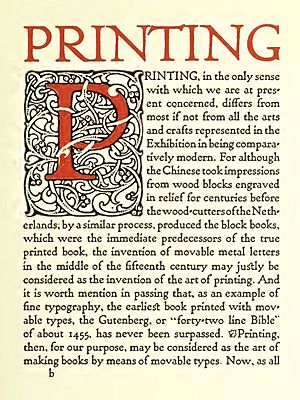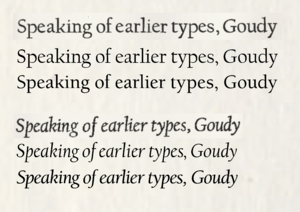Frederic Goudy facts for kids
Quick facts for kids
Frederic Goudy
|
|
|---|---|

Goudy in 1924
|
|
| Born |
Frederic William Goudy
March 8, 1865 Bloomington, Illinois, U.S.
|
| Died | May 11, 1947 (aged 82) Marlborough, New York, U.S.
|
| Occupation |
|
| Known for |
|
| Spouse(s) |
Bertha Matilda Sprinks
(m. 1897; died 1935) |
Frederic William Goudy (March 8, 1865 – May 11, 1947) was a famous American printer, artist, and type designer. He created many well-known typefaces, which are the different styles of letters we see in books and on screens. Some of his most famous designs include Copperplate Gothic, Goudy Old Style, and Kennerley. He was one of the most active type designers in America. His typefaces are still very popular today.
Frederic Goudy's Life Story
Frederic William Goudy was born on March 8, 1865, in Bloomington, Illinois. He didn't start as a type designer right away. When he was 40, he was working as a bookkeeper and felt like he hadn't achieved much.
How Goudy Became a Type Designer
Over the next 36 years, Goudy became a master of type design. He created 113 different fonts. This was more usable typefaces than many other great inventors of type combined! He started this career later in life than most people.
Goudy first taught lettering and became known for designing advertisements in Chicago. In 1895, he opened his own printing shop called Booklet Press. He designed his first typeface, Camelot, in 1896.
Starting the Village Press
In 1903, Goudy and Will Ransom started the Village Press in Park Ridge, Illinois. They wanted their printing to be like the beautiful books made during the Arts and Crafts movement. This movement focused on handmade quality and traditional skills. Their first typeface for the press was called "Village."

The Village Press moved to Boston and then to New York. In 1908, Goudy designed a typeface called E-38 for the Lanston Monotype Machine Company. Sadly, that same year, the Village Press burned down. All of Goudy's equipment and designs were lost in the fire.
Creating Famous Typefaces
In 1911, Goudy created his first big success, Kennerley Old Style. This typeface was used for a book by H. G. Wells. After this, he designed another popular typeface called Forum.
The American Type Founders Company (ATF) noticed Goudy's talent. They asked him to create a new typeface for them. Goudy agreed, but only if they wouldn't change his original drawings. This new typeface became Goudy Old Style.
Goudy Old Style was released in 1915 and became very popular right away. It was great for newspaper ads because it used space well. ATF made many more typefaces based on Goudy's design, like Goudy Bold and Goudy Extrabold. However, Goudy had sold his original design for a fixed price ($1,500). He didn't get any extra money (royalties) when his designs became super successful. This made his relationship with ATF difficult.
Later Years and Challenges
From 1920 to 1947, Goudy worked as an art director for Lanston Monotype. He also worked from his own workshop in Marlborough, New York, which he called the Village Letter Foundery. He preferred working there because he felt the Monotype company changed his designs too much. Goudy drew all his typefaces by hand, without using rulers or compasses.
In 1939, another fire destroyed the Village Letter Foundery. Much of his work was lost again. But two of his successful designs, Deepdene and Goudy Text, survived.
Goudy's Legacy and Family
Goudy was well-known from 1915 to 1940. This was not only because of his successful typefaces but also because he gave many talks. He loved talking about letter forms and good printing. He once said, "My craft is a simple one. For nearly forty years I have tried to make people appreciate good printing and typography more. I wanted to give printers and readers more readable and beautiful types."
By the end of his life, Goudy had designed 122 typefaces and published 59 books. He worked closely with his wife, Bertha M. Goudy, who helped him with printing projects. They had a son named Frederic T. Goudy.
Goudy is also famous for a saying about typography: "Anyone who would letterspace lowercase would steal sheep." This means he strongly disliked adding extra space between lowercase letters.
Goudy's Typeface Designs
Goudy was one of the most active designers of metal type in the United States. He created 90 typefaces that were actually made and used. He also worked on many hand-lettering projects, especially when he was younger. He even designed a large set of ampersands (the "&" symbol) for an article.
Goudy's Style and Influences
Goudy's career was greatly shaped by the Arts and Crafts movement. He loved the idea of beautiful, well-made books. At a time when many printing types looked very mechanical, Goudy focused on creating "old-style" typefaces. These often had a warm, slightly uneven look, inspired by old Italian printing and calligraphy. His neighbor, Eric Sloane, said Goudy also got ideas from hand-painted signs.
Unlike some other designers, Goudy usually avoided sans-serif designs. Sans-serif letters do not have the small decorative lines (called serifs) at the end of strokes. However, he did create Copperplate Gothic, which looks almost sans-serif. It was inspired by engraved letters. Many of his designs might look similar to each other because he stuck to his unique style. He also designed typefaces inspired by medieval manuscripts and old Roman letters carved in stone.
How Goudy Created Typefaces
As an independent artist, Goudy took on many different jobs to make a living. Companies would ask him to design a special typeface for their printing and advertising. This helped him create many designs and become well-known through his talks and teaching.
New technology helped Goudy a lot. The pantograph engraving machine made it easier to create the metal molds (called matrices) used to make metal type. Before this, designers had to carve punches by hand for each letter size. Another helpful invention was hot metal typesetting. This technology made new fonts more available and in demand.
Different Opinions on Goudy's Work
While Goudy's designs are mostly "old-style" serif faces, they still show a lot of variety. For example, Deepdene has a very upright italic style. Goudy Modern mixes traditional old-style letters with the strong, horizontal serifs of 18th and 19th-century typefaces. Goudy Old Style even came with fancy, flowing italic letters for special uses.
Goudy kept records of his work, numbering his typefaces like composers number their musical pieces. He also wrote a lot about his designs, which is rare for type designers of his time.
Not everyone loved all of Goudy's work. Some printers, like Daniel Berkeley Updike and Stanley Morison, respected parts of his work but also had criticisms. They felt his designs sometimes lacked a certain sharpness or were too focused on imitating old medieval books. Goudy himself felt later in life that his style was becoming less popular as new, more geometric designs became trendy.
Special Typefaces for Universities
In 1938, Goudy designed University of California Old Style specifically for the University of California Press. Later, in 1956, the Lanston Monotype Company released a version of this typeface called Californian for everyone to use. In 1983, another company, ITC, made a popular updated version called Berkeley Old Style or ITC Berkeley.
A curator at Syracuse University found some old metal molds and papers for a font called Sherman. Frederic Fairchild Sherman had asked Goudy to design this font in 1910. Sherman's niece later gave the font to Syracuse University because Goudy had a connection there. Syracuse University had given Goudy an honorary degree and a medal for his excellent typography. Recently, Syracuse University made a digital version of the Sherman typeface. It is now called Sherman Serif Book and is used for the university's official publications.
See also
 In Spanish: Frederic William Goudy para niños
In Spanish: Frederic William Goudy para niños


